Mid century 1950’s modern furniture has simplicity and durability at the core of its design, making it both an ideal choice for a comfortable home and a lifelong investment. This period of furniture can be dated back to the post-war era, gaining major influence in the 1950s and 1960s across the western world, with particularly popular pieces being produced in Scandinavia. Materials can vary from synthetics, plastic and metal as well as the use of solid teak, oak, walnut and rosewood.
 Above: a selection of mid century modern chairs from original magazine advertisements
Above: a selection of mid century modern chairs from original magazine advertisements
The affordability and mainstream appeal of these pieces has seen a revival in recent years, but although mid century furniture is known for its enduring appeal and longevity, it can also face damage from everyday accidents or absence of care over recent decades. The materials can often differ greatly from those used in traditional antique furniture, creating new dangers to be aware of – for example, the staining of plastics and faux veneer features or the rusting, scratching or blemishment of industrial metals.
 Above: examples of wooden mid century furniture designs including an armchair and wishbone dining set
Above: examples of wooden mid century furniture designs including an armchair and wishbone dining set
Common damages to mid century furniture may also come from amateur ‘restoration’ attempts by those who might not have been aware of the value or desirability of the chair, table, or sideboard. This includes the painting over of original wood features, the relining of drawers with acidic glues, new upholstery in a textile which is not period-appropriate and homemade craftsmanship attempts which have taken away the original aesthetic quality of the furniture. On some occasions these unwanted furniture revivals can be restored back to their original state or minimised as much as possible, with the help of our qualified furniture team who work with historic accuracy at the forefront of their minds.
 Above: examples of mid century living spaces including coffee tables and armchairs
Above: examples of mid century living spaces including coffee tables and armchairs
Most pieces of mid century modern furniture can be simply cared for with easy techniques, which we will cover in more detail in this article. On the occasion that more drastic or embedded damage is present, our furniture restoration team is on hand to provide tailored care to all aspects from wobbling joins and broken legs to stained surfaces and unwanted renovations.
Styles of mid century furniture
The most common styles of mid century modern furniture can be linked back to influential designers. As well as the usual pieces for a home, such as tables and chairs, mid century furniture also saw the mainstream use of modern items such as television stands, coffee tables, and even serving tables on wheels for family dinners.
 Above: mid century modern furniture in their original interiors during the 1950s & 1960s
Above: mid century modern furniture in their original interiors during the 1950s & 1960s
Charles and Ray Eames were a husband and wife team notable for their leather lounge chair and ottoman, complex storage units (such as the ESU 426-C), the colourful hang-it-all coat hooks, and office ‘task’ chairs. The Eames also designed the DSR chair – standing for Dining (height) Side (chair type) Rod (base material) to note the simplicity of the concept – of which the originals were made of fibreglass and are now commonly made of polypropylene.
 Above: a selection of Eames chairs including two DSR chairs and their iconic leather armchair with foot rest
Above: a selection of Eames chairs including two DSR chairs and their iconic leather armchair with foot rest
The popular tulip chair was designed between 1955-56 by Eero Saarinen, a Finnish-American designer who also created the womb chair and played a key role in the construction of several important pieces of architecture in the United States – including the Gateway Arch in St. Louis. The tulip chair is reflective of this era in design due to the industrial nature of the construction, formed seamlessly in one piece using fibreglass and cast aluminum. The modernist design was seen to be futuristic and is still often associated with a retro ‘space age’ aesthetic for interior designers. The utility, like all mid century pieces, is also simple for a modern lifestyle, allowing the upholstered cushion to be removed with velcro for an easy clean, whilst the base can simply be wiped down without any heavy duty care required.
 Above: a selection of mid century chairs with various materials including plastic, textiles, fibreglass and metal – left & right examples of tulip chairs
Above: a selection of mid century chairs with various materials including plastic, textiles, fibreglass and metal – left & right examples of tulip chairs
Furniture by named designers, especially those which are of the original era and not reproductions, can fetch high sums at auction and are valued highly by collectors and enthusiasts around the world. Whilst mid century pieces were designed for their durability and simplicity in everyday care, we do recommend that they are still treated as valuable items and with as much vigilance as that of a traditional antique. Areas on items like a tulip chair, such as the bright white base, may still face staining and discolouration over time – requiring professional attention by our trained furniture specialists.
Caring for mid century modern 1950’s furniture
Everyday care for mid century 1950’s furniture includes chairs, tables, sideboards, dressers, and wardrobes, all of which may have all faced damage from their use as a functional piece of family furniture over the decades.
Mid century – 1950’s – furniture restoration and care can be as simple as a light dusting with a dry, soft cloth or feather duster. Materials such as teak can be extremely durable when it comes to accidental spills, as long as it is quickly mopped up with a clean towel and not upon an untreated, porous part of the wood.
 Above: surfaces of furniture can become stained, strained, dented and blemished over time
Above: surfaces of furniture can become stained, strained, dented and blemished over time
Durability against spillages and other accidents can also be built up over time with further care methods appropriate for the materials and design. For a more intense routine, solid wood such as teak can be treated with oil to preserve the correct levels of moisture in the wood, as this timber may weaken if it becomes too dry over time. When performing this ensure that somebody with confidence and experience is involved, if you are at any point unsure about treating or oiling furniture, please feel free to speak to our helpful team for professional advice and services.
 Above: various methods can be used to strengthen wooden surfaces, but these should be appropriate for the era and design
Above: various methods can be used to strengthen wooden surfaces, but these should be appropriate for the era and design
Applying oil to teak furniture
When applying oil to mid century teak furniture, make sure that you have purchased a non-toxic or non-acidic oil solution which is natural, meaning it is free of petroleum, silicones and any type of varnish. The use of a universal furniture oil or one with these added features may lead to damage or disruption of the design and surfaces, so ensure that the label reads it is suitable precisely for teak and as pure as possible.
 Above: a typical teak furniture surface with a warm tone
Above: a typical teak furniture surface with a warm tone
Before applying, protect surrounding furniture and ensure the wood is dusted and clean – you can clear dust away easier with a slightly moistened cloth. Then, using a clean cloth, soak up oil and wipe the wood in a motion that goes in the direction of the wood grain. Once complete, leave the furniture for as long as possible to dry – around 24 hours – until the oil has been absorbed and the surface is no longer shiny or sticky to touch. If you notice any patches over the next few hours, you can retouch them and reapply the oil for an even finish.
 Above: oil being applied to a wooden surface with a careful and even application – gloves should be worn to avoid greasy hands
Above: oil being applied to a wooden surface with a careful and even application – gloves should be worn to avoid greasy hands
Oil should only be applied every six to twelve months, making this a low maintenance way to strengthen your mid century furniture. If a piece is located in a warm location, it may need this more frequently to avoid drying out and becoming weak.
Mid century 1950’s furniture restoration
Our skilled furniture team is able to restore mid century modern designs in a number of ways – whether this is a small area of discolouration or a severe breakage in the structure. When everyday care for this furniture is unable to prevent or remove damage, our team can step in to help with tailored treatments.
In our furniture restoration studio, all items are cared for with historically accurate approaches. This means that a 17th century cabinet is treated with 17th century techniques, whilst a mid century piece will have interventions only appropriate for the 1950s or the decade of it’s design. Where possible, our furniture team strives to only use replacement parts from the exact era and will only reapply finishes or varnish if this is appropriate.
 Above: mid century interiors – restoration of furniture and decorative items from this period should always be historically appropriate for the era
Above: mid century interiors – restoration of furniture and decorative items from this period should always be historically appropriate for the era
When a piece of 1950’s and 1960’s furniture has been restored in the past with an amateur approach or has faced alterations over time, our team can also help to reverse these changes as much as possible, bringing back the original design quality to the furniture.
 Above: the results following a restoration in our studio of a large table with multiple watermarks and staining to the surface
Above: the results following a restoration in our studio of a large table with multiple watermarks and staining to the surface
Loose joins and wobbly furniture can be stabilised with careful craftsmanship, in some cases our team can take apart and reconstruct furniture to return strength. Broken legs or arms of chairs, tables and other pieces of furniture can also be secured with the original or new parts which are appropriate for the era. The same is possible for broken upholstery which may need to be stabilised or replaced.
Stains or discolouration to plastics, metals or further materials can be treated with a tailored solution for a gentle removal, ensuring that no damage occurs to the original structure of the design, returning the aesthetic value.
 Above: many types of mid century modern furniture can be restored – from full dining sets to television stands
Above: many types of mid century modern furniture can be restored – from full dining sets to television stands
How can we help?
There are many areas of damage which our team can assist you with, so please get in touch for advice and a full assessment to see how we can help you in reviving a mid century design.
To make contact regarding 1950’s furniture restoration please email us via [email protected] or call 0207 112 7576

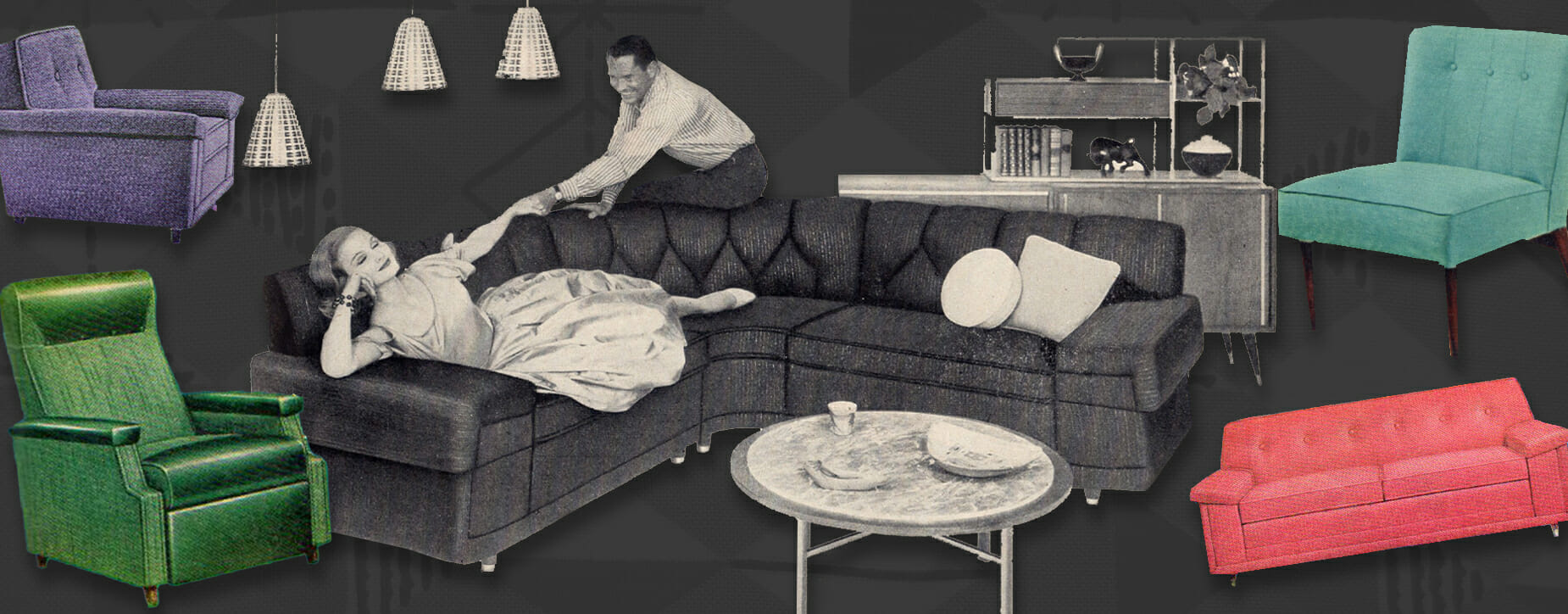 Above: a selection of mid century modern chairs from original magazine advertisements
Above: a selection of mid century modern chairs from original magazine advertisements Above: examples of wooden mid century furniture designs including an armchair and wishbone dining set
Above: examples of wooden mid century furniture designs including an armchair and wishbone dining set Above: examples of mid century living spaces including coffee tables and armchairs
Above: examples of mid century living spaces including coffee tables and armchairs Above: mid century modern furniture in their original interiors during the 1950s & 1960s
Above: mid century modern furniture in their original interiors during the 1950s & 1960s Above: a selection of Eames chairs including two DSR chairs and their iconic leather armchair with foot rest
Above: a selection of Eames chairs including two DSR chairs and their iconic leather armchair with foot rest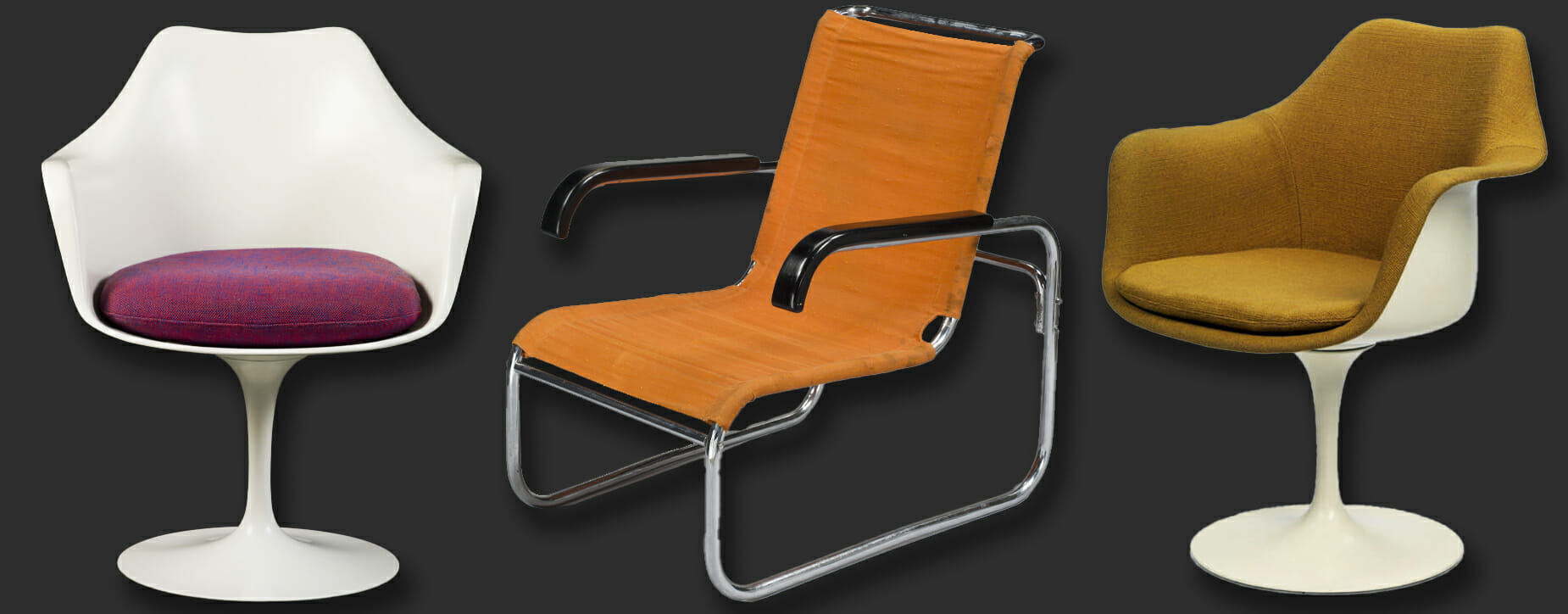 Above: a selection of mid century chairs with various materials including plastic, textiles, fibreglass and metal – left & right examples of tulip chairs
Above: a selection of mid century chairs with various materials including plastic, textiles, fibreglass and metal – left & right examples of tulip chairs Above: surfaces of furniture can become stained, strained, dented and blemished over time
Above: surfaces of furniture can become stained, strained, dented and blemished over time Above: various methods can be used to strengthen wooden surfaces, but these should be appropriate for the era and design
Above: various methods can be used to strengthen wooden surfaces, but these should be appropriate for the era and design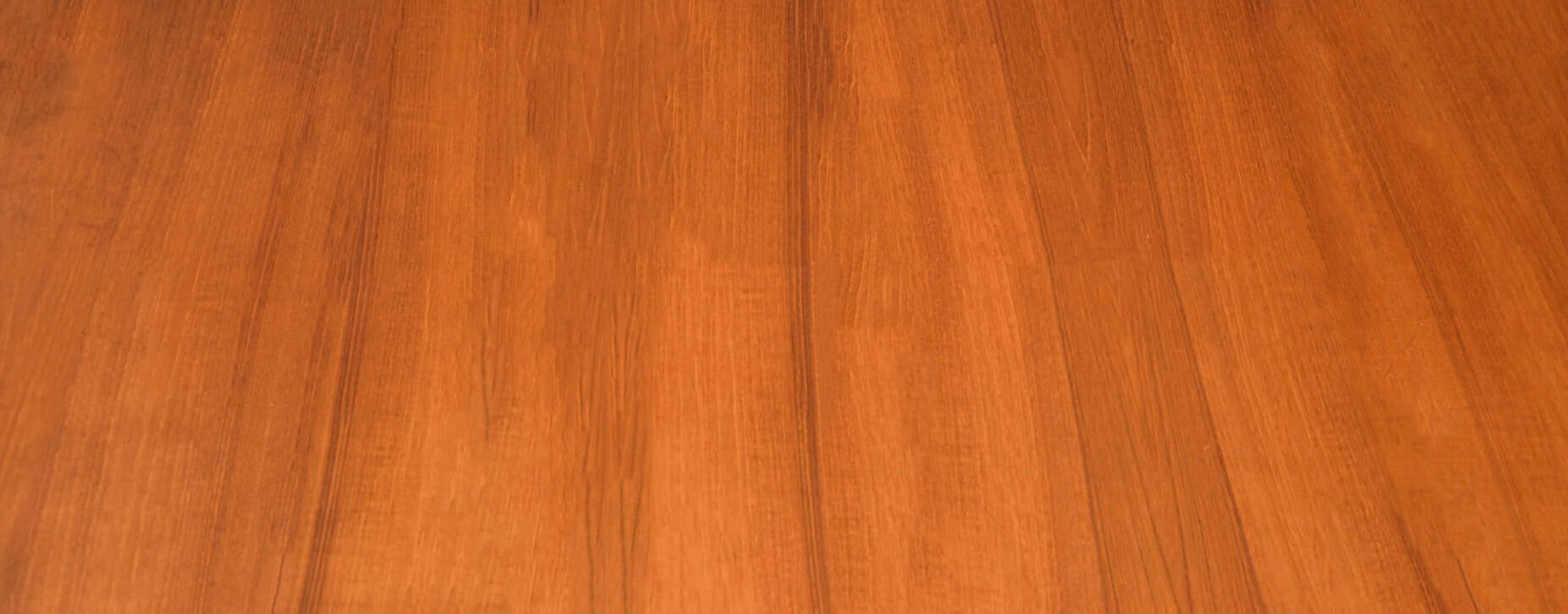 Above: a typical teak furniture surface with a warm tone
Above: a typical teak furniture surface with a warm tone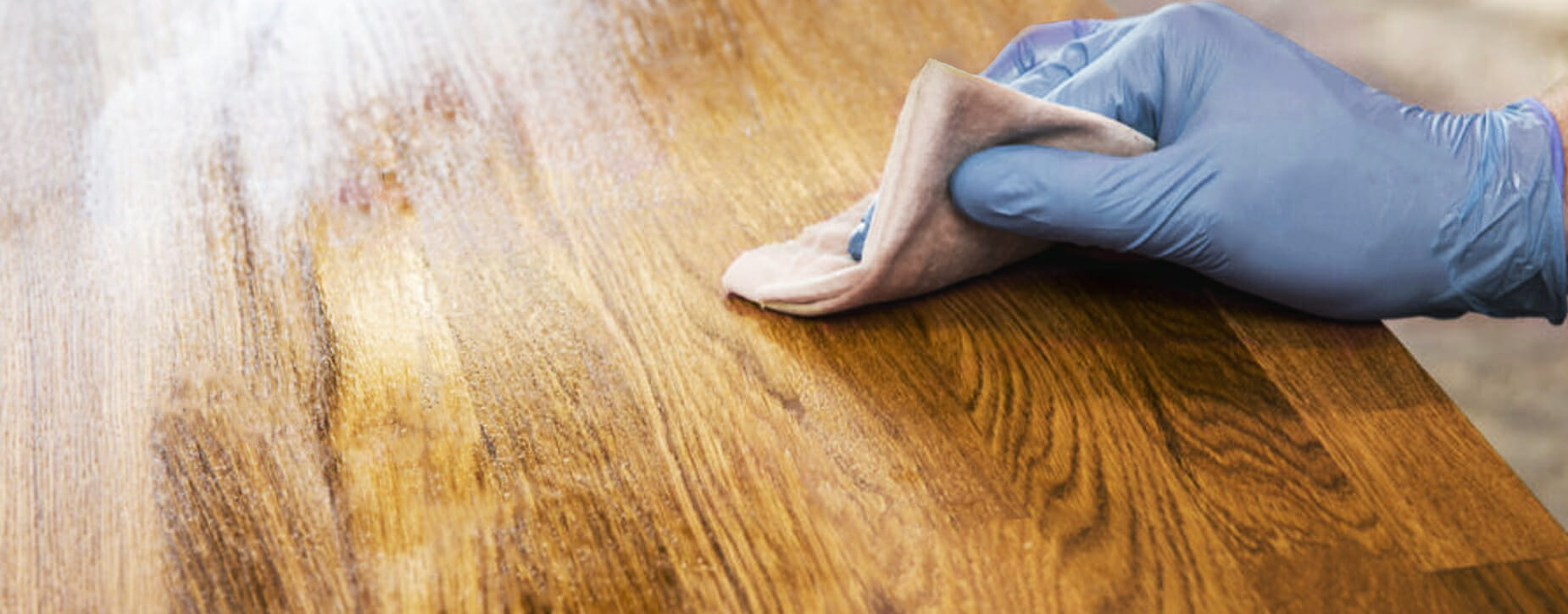 Above: oil being applied to a wooden surface with a careful and even application – gloves should be worn to avoid greasy hands
Above: oil being applied to a wooden surface with a careful and even application – gloves should be worn to avoid greasy hands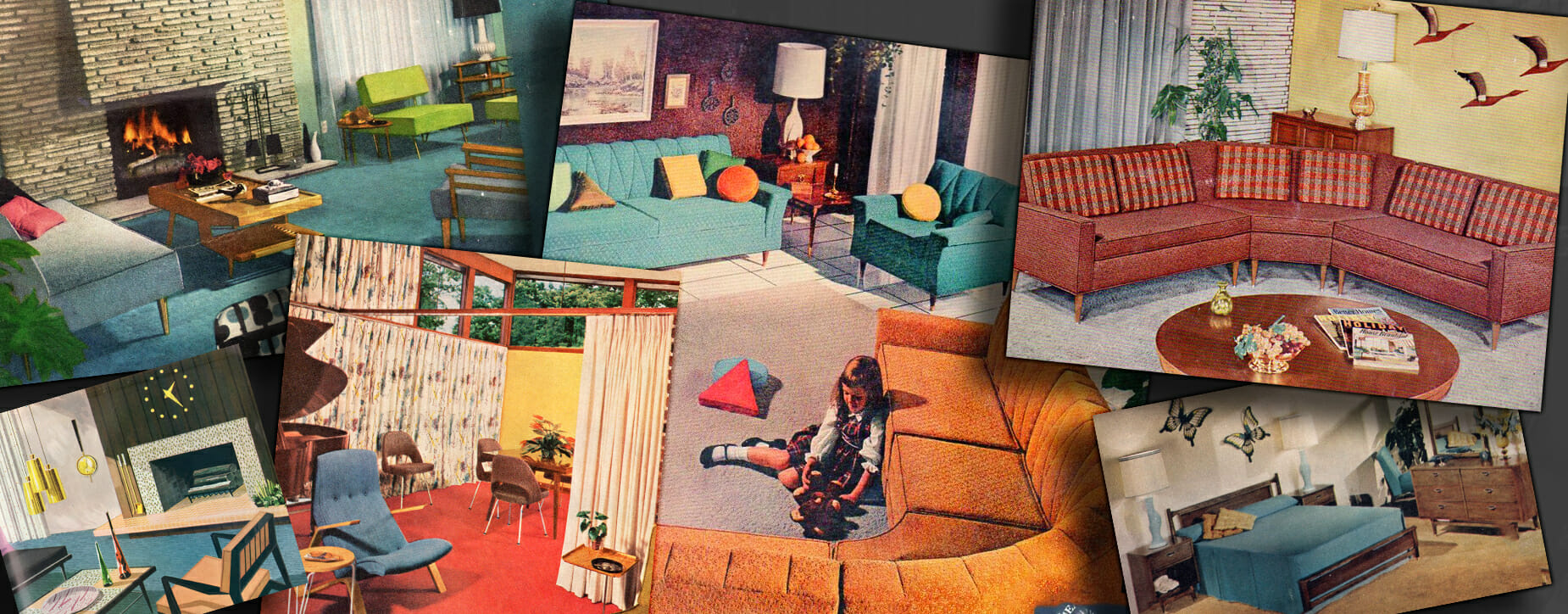 Above: mid century interiors – restoration of furniture and decorative items from this period should always be historically appropriate for the era
Above: mid century interiors – restoration of furniture and decorative items from this period should always be historically appropriate for the era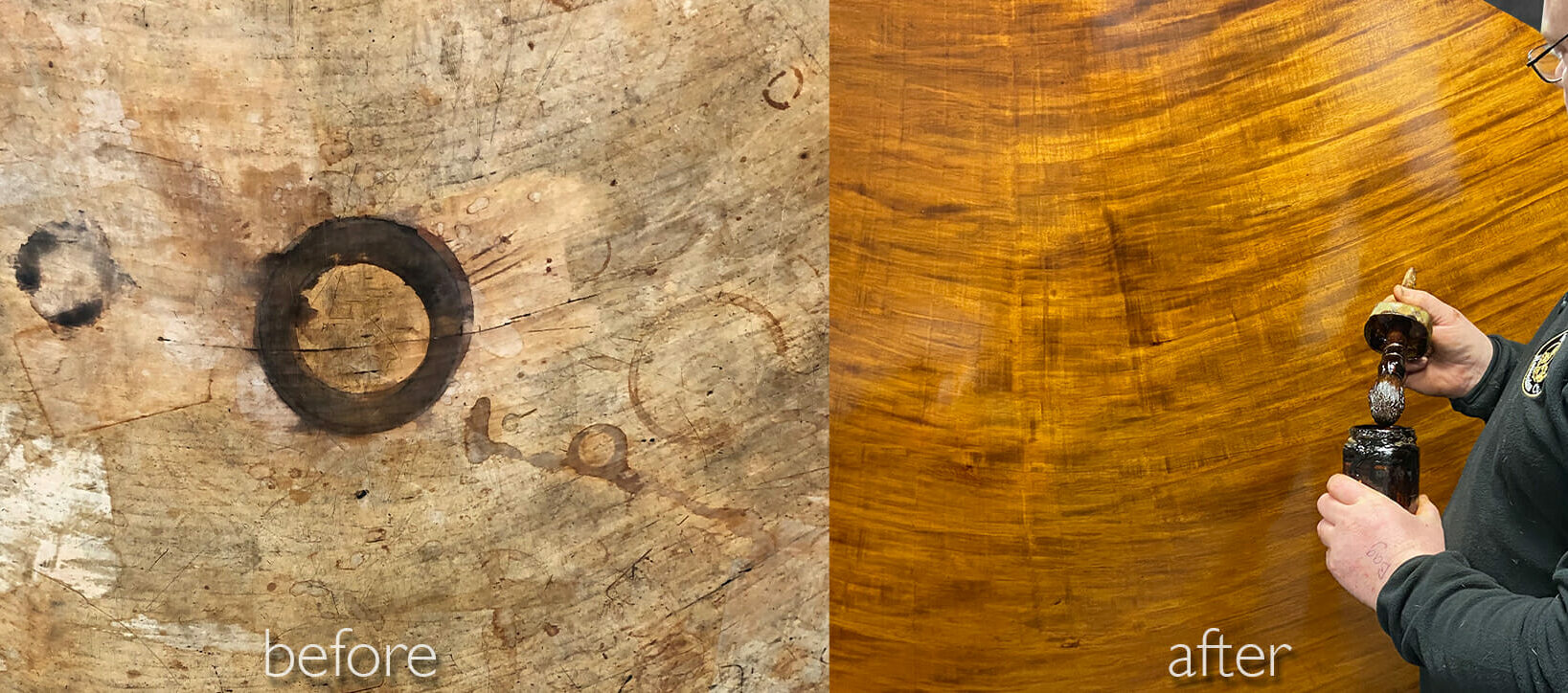 Above: the results following a restoration in our studio of a large table with multiple watermarks and staining to the surface
Above: the results following a restoration in our studio of a large table with multiple watermarks and staining to the surface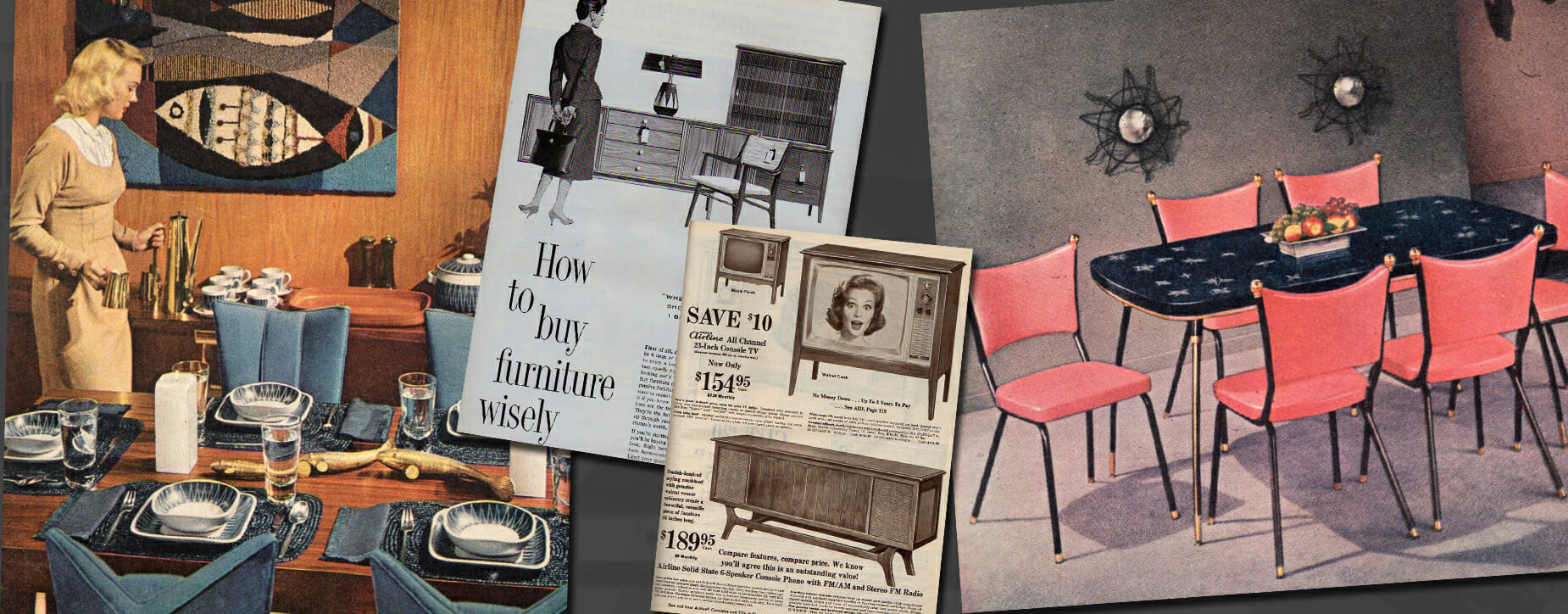 Above: many types of mid century modern furniture can be restored – from full dining sets to television stands
Above: many types of mid century modern furniture can be restored – from full dining sets to television stands 




